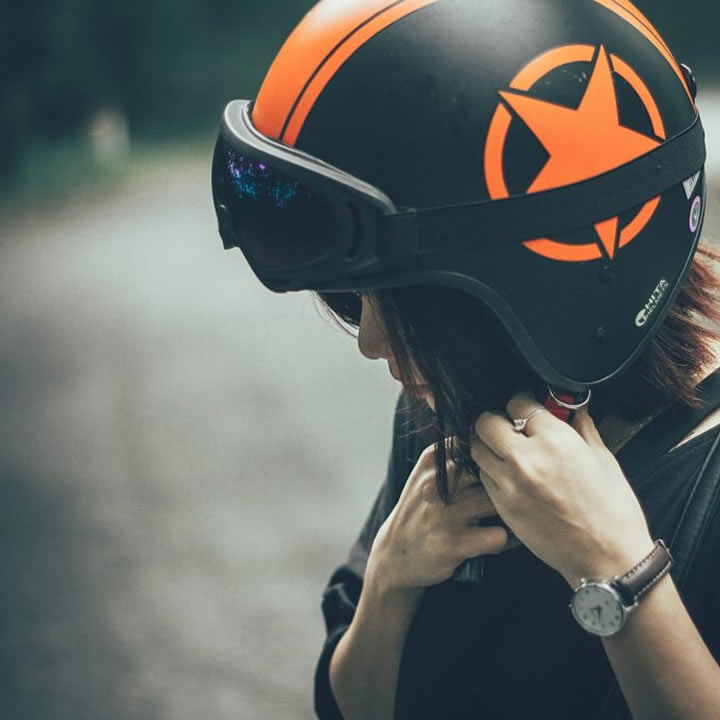There is no doubt that the most important piece of protective gear when riding a bike is the helmet. Why? This can be easily explained by looking at the following scenario: while all the other protective pieces of equipment are significant, if you have an accident and fall off your motorcycle, you may sustain various injuries on your body that will heal eventually.
But if you hit your head to the pavement and do not have a helmet, you may never be able to get up and live to tell the tale. Even if your country or state does not require you to wear a helmet, you should do so anyway because safety is important.
Now, you may be young and restless, and you may feel cool by bending the rules, but if you value your life, this is not something you should not be serious about.
If you are a beginner, you should know that there are various types of helmets for different types of motorcycles and rides.
Full-face helmets
This type provides the most coverage around your neck and head. The full-face helmet is considered to be the safest type to protect you from a potential impact. The chin bar is a distinguishing protective feature that most other types of helmets lack. This characteristic protects your chin and jaw.
Unfortunately, in most serious accidents, these areas are somewhat exposed, so it is important to protect them as much as possible. This is a versatile choice for all types of riders as well as motorcycles. Even if you have very specific tastes, you are sure to find really nice ones, as the market has plenty to offer.
As mentioned earlier, full-face helmets also adapt to the types of bikes and rides. For example, since they have a crouched riding position, sports riders need helmets which prevent them from lifting at very high speeds. Therefore, they are designed with a higher chin bar, as well as a visor opening that is slightly angled toward the top.
For cruisers, tourers, and adventure riders, the helmet has a lower chin bar, while the visor opening is straightforward because of the riders’ upright position. If you want to purchase such a helmet, make sure that it also has ventilation which reduces visor fogging, evaporates sweat, and also keeps you cool while riding.
Of course, if you are willing to spend more, you can also go for a more modern model that comes with high-visibility color designs and options, Bluetooth speakers, or visors that adjust to sunlight conditions.
Modular helmets
This type is also known as a flip-up helmet. These are a mix between a full-face helmet and a 3/4 helmet. What distinguishes these items is that the visor and the chin bar can flip up in order to open the front of the helmet.
They usually include a visor for the protection of the eyes, and some models can also include a secondary internal visor as an extra layer of eye protection from the sun. You need to know that modular helmets weigh more than the standard full-face helmets because of the extra design hinge features that are included in the flip-up area.
It is also important to mention that the hinge structure slightly reduces the safety of the rider, due to the small fissure. However, the flip-up helmet offers more chin protection. This is often the choice of adventure riders, tourers, and cruisers because it comes with a design for an upright riding position.
Open-face helmets
These are also known as 3/4 helmets. They cover only the top back and the sides of your head, while leaving your face exposed. This model is popular with tourers, scooters, cruisers, and cafe racers because it allows the riders to feel the wind on their skin. While this feeling is amazing, there is no doubt about it, it is the least safe option of them all.
Actually, the least safe option would be not wearing a helmet at all. In terms of the areas where they do offer coverage, the open-face helmets are considered equals to the full-face models, structurally speaking.
Naturally, these helmets are lighter than the other types because of the absence of a chin bar. Still, the difference in weight is not that big. Another thing you ought to consider is that the 3/4 helmet cannot protect you from severe weather conditions, nor from road debris.
A word from the wise
We have mentioned this before, but we cannot stress enough how important this piece of equipment is. Not only does it keep you safe from possible head injuries, but it can also improve your riding experience.
Not wearing a protective helmet puts you at great risk, and it is very unpleasant to constantly fight insects and various road debris while riding.

